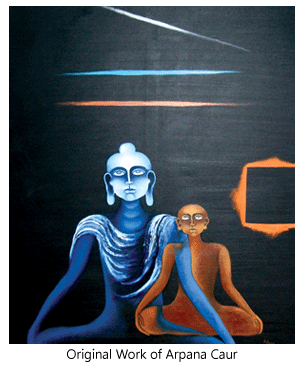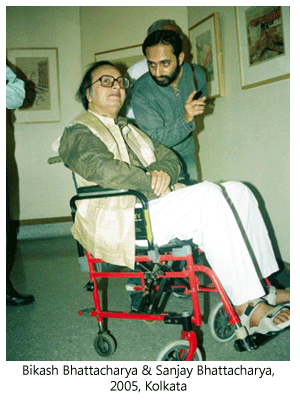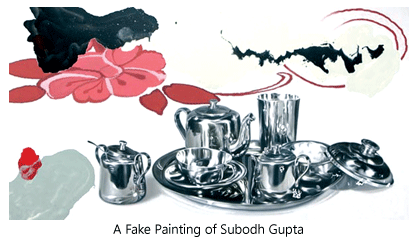- Prelude
- Editorial
- A Conversation with Jagdish Swaminathan
- Seeing is Very Important………
- Tormented Delineations and Violent Deformations
- Bikash Bhattacharjee: Subverting the Seen
- Bridging Western and Indian Modern Art: Francis Newton Souza
- Contesting National and the State: K K Hebbar's Modernist Project
- The Allegory of Return into the Crucial Courtyard
- Knowing Raza
- The Old Story Teller
- Beautiful and Bizarre: Art of Arpita Singh
- Feeling the Presence in Absence! Remembering Prabhakar Barwe
- Waterman's Ideal Fountain Pen
- Peepli Live: the Comic Satire Stripping off the Reality of Contemporary India
- Age of Aristocracy: Georgian Furniture
- Faking It - Our Own Fake Scams
- Scandalous Art and the “Global” Factor
- The Composed and Dignified Styles in Chinese Culture
- Visual Ventures into New Horizons: An Overview of Indian Modern Art Scenario
- The Top, Middle and Bottom Ends
- Top 5 Indian Artists by Sales Volume
- What Happened and What's Forthcoming
- The Month that was
- NESEA : A Colourful Mosaic
- Mumbai Art Sighting
- Art Events Kolkata
- Musings from Chennai
- Art Bengaluru
- Khoj, Kolkata Boat Project
- What a Summit!
- Ganesh Haloi at Art Motif
- The Other Self by Anupam Sud at Art Heritage, New Delhi
- Baul Fakir Utsav at Jadavpur
- Printmaking Workshop
- World's Greatest Never Before Seen Toy and Train Collection
- Previews
- In the News
- Christies: Jewellery Auction at South Kesington, London
ART news & views
Faking It - Our Own Fake Scams
Volume: 3 Issue No: 13 Month: 2 Year: 2011
Through the Looking Glass
by JohnyML
LA few years back, while viewing some paintings in a group show held at a very famous gallery in Delhi, I chanced upon a painting by Arpana Caur. On a second look, I thought it was a work done by Arpana in some camps where one had to rush with the works. In such cases though stylistic features remain the same, finer details get lost. However, it was not a work produced at any art camp. The show had a theme and the work seemed to have all the required details that fulfilled the demands of the curatorial theme and yet somewhere it looked different from an original Arpana Caur.  I informed the artist about this encounter and she went and saw the work herself. First, she was shocked to see a fake like that and later to my surprise she decided to keep silent on the whole issue.
I informed the artist about this encounter and she went and saw the work herself. First, she was shocked to see a fake like that and later to my surprise she decided to keep silent on the whole issue.
Arpana's is not an isolated incident. There have been a number of cases in the last two decades where artists had to keep quiet on the circulation of their fakes in the market. There are two reasons why artists and the concerned parties hush up such incidents; one, no artist wants to let the whole world know that his/her work is faked, which would eventually cast aspersions on the originals as well. Two, the faking network was taken for granted because the faked works never came to the mainstream markets, till they did start coming. In the last one decade, several cases of fakes appearing in some of the most distinguished auction houses have made art professionals to sit up, think and voice their concerns.
It is said that a large number of the works of art that are being circulated in the international art market is fake. Though it is a gigantic figure, in India, the percentage is supposedly less as most of the fakes find their spaces in farm houses and rich people's mansions and television and film sets as 'stand in' pieces of the original works. However, the moment these works are pushed to the auction scene within an intention to pass it off as originals and make profit out of it, the issue becomes grave.
Counterfeiting is a byproduct of the mainstream market. The more a commodity gains demand in the market the more are the chances of getting it counterfeited. When there was no worth mentioning art market in the Indian scene, the fakes were almost lauded as necessary evils. Even state run agencies like Lalit Kala Akademy have 'certified' fakes in their collection. Recently I had this rare opportunity of seeing an MF Husain original along with an MF Husain copy in the Lalit Kala Akademy, New Delhi collection.  There was an auction in Delhi with a particular Souza being priced at Rs 85,000, when an exact copy of the work was selling at another show for Rs 40,000.[1] I have also seen the mansions of art collectors filled with fake works of art. But that was the story of the pre-market decades. Also that was/is the story of a parallel market that caters to those people who always prefer the 'stand in-s' rather than the originals.
There was an auction in Delhi with a particular Souza being priced at Rs 85,000, when an exact copy of the work was selling at another show for Rs 40,000.[1] I have also seen the mansions of art collectors filled with fake works of art. But that was the story of the pre-market decades. Also that was/is the story of a parallel market that caters to those people who always prefer the 'stand in-s' rather than the originals.
In March 2006, when Nevile Tuli's auction house, Osians produced a work of Bikash Bhattacharjee, the art world was scandalized. It was one of the pioneering incidents in which a work was called a fake (it was pointed out by Sanjay Bhattacharya, a contemporary artist and the student of Bikash Bhattacharjee) and was withdrawn from auction. This incident was the tip of the iceberg and when someone dared to expose it more stories started coming in. In 2008, when Gallery Espace in New Delhi presented an exclusive solo show of Somanath Hore, the artist's daughter, Chandana Hore herself came forward to say that the works in the show were fakes. In this case the gallery was taken for a ride by one of the relatives of the late artist. Similarly, in 1990 nine fake works of MF Husain were sold by a leading art gallery in Chennai. Mustafa, Husain's son, raised the alarm after he spotted that the Raja and Rani from the artist's Raj series was a fake. [2]
Galleries and collectors often get fooled by the relatives of the artists. Many a times, driven by greed and family disputes on the estate of the artists, close relatives of the artists delve in faking the works FN Souza himself was reported to have dissuaded his clients from buying works from his own son. In its October 28th, 2005 edition DNA, the Mumbai based newspaper states: 1998 Art buyer Nisha Jamwal told DNA, "I contacted FN Souza when his son, Patrick offered 50 odd Souzas for only Rs 20,000 each. He wrote back saying all of them were fake and done by Patrick." [3]
Jamini Roy is one of the Indian artists who have been faked by many, including relatives, acquaintances, students and unsuccessful artists. In one of the recent incidents, Dhoomimal Gallery in  Delhi got into soup by displaying the faked works of SH Raza, who interestingly was present during the opening of the show. The gallery had to scrap the show as the artist himself identified almost all the works as fake. Interestingly, once again all these works came from the artist's relative.
Delhi got into soup by displaying the faked works of SH Raza, who interestingly was present during the opening of the show. The gallery had to scrap the show as the artist himself identified almost all the works as fake. Interestingly, once again all these works came from the artist's relative.
Those people, who have studied the issue of faking art closely, say that artists giving assistants access to their works by often allowing them to finish their works and thereby gaining knowledge to the modalities of making, risk faking by the assistants. In 2004 Hamid Safi, was arrested for producing fakes of Anjolie Ela Menon. Safi had assisted Menon for 20 years. [5]Generally no artist would promote his/her assistants as independent artists and their perpetual inferior status is perhaps exploited by the faking mafia. Also, there are interesting cases in which the assistant almost copy the style of their master and then get established as independent artists. Only this kind of artists could save their faces from being called 'fakers'.
The faking industry is nebulous and the alarming thing is that even the existence of fakes is wished aside until it becomes a public scandal. The vigilant observers have proposed ways to protect the art industry from falling prey to the faking industry. Primarily, it is proposed that all the artists should have register the provenance of their works with safe hands and they should not promote any chance of faking by authenticating any work other than the ones done by themselves. Galleries and other responsible art professionals should be working only with works that are authenticated by scholars and the artists themselves. Another proposal says that there should be a centralized body that would keep the provenance of the works produced in the country in proper documentation. Also it is proposed that those people indulge in faking works of art should be treated as economic offenders and they should be brought under the laws which deal with economic offences.
Despite all these proposals Indian art scene has not moved any further in solving the issue of fake art. Though, after a few incidents of fakes surfacing in shows and auctions the concerned parties have become vigilant. But mere vigilance does not serve the purpose. There should be a mechanism that involves both the state and private agencies along with scholars, artists and professionals to keep an eye on the faking industry. Also there should be incorporation of newer laws to handle the newer problems of copyright and related issues.
The issue of faking, during the last two decades has even elicited curiosity from the literary people and their enquiries too have taken them to the high seats of art professionals who handle art by collecting and dealing. In her novel Faking it published in 2009 author Amrita Choudhury depicts the life of Tara Malhotra, who is forced to relocate herself to Mumbai during the boom years. She buys an Amrita Sherghil work and soon realizes that it is a fake. And she starts hunting for the origin of that fake and to her surprise and shock, she comes to know how some of the movers and shakers of the art scene on whom she had invested money, respect and love involved in faking the works and selling one of them to her. Novels tell truth using fantasy as a tool. But fantasies also represent reality.
Reference:
[1]. Indian Express Newspapers (Bombay) Ltd, Date: Friday, April 10, 1998. By: Suneet Chopra. (http://www.expressindia.com/fe/daily/19980410/10055454.html)
[2]. INDIA TODAY, http://www.india-today.com/itoday/20040705/society1.html, July 05, 2004)
[3]. http://www.dnaindia.com/lifestyle/salon_have-you-just-bought-a-fake_7539
[4]. (From: bca galleries, http://www.bcagalleries.com/notesboard.asp?CAT_ID=1563&parent=66&cat_rep=&cat_name=Fake).
Editorial Remarks
Other incidents pertaining faking:
In 2008, 9th March, Mumbai, the owner of Sahiil Art Gallery, Colaba, Shamsunder Desai was arrested for trying to sell a fake painting of renowned artist Subodh Gupta. A Delhi-based art dealer Raju Tiwari wanted him to sell the painting from his art gallery. "I paid Rs 4 lakh as advance for this painting of Subodh Gupta to Raju Tiwari," said Desai.
Since he was not acquainted with the works of Subodh Gupta and so he was not able to make out that it was a fake.
From: Mid-day (Mumbai), Date: March, 09, 2008. By: Vinod Kumar Menon. (http://www.mid-day.com/news/2008/sep/030908-shamsunder-desai-cheated-fake-art-dealer-subodh-gupta-paintings-scams.htm)
In 1998, an art collector bought a Ganesh Pyne from a gallery better known for its sale of fakes in Mumbai. When the artist was contacted by the buyer, he confirmed the work was a fake. There was an auction in Delhi with a particular Souza being priced at Rs 85,000, when an exact copy of the work was selling at another show for Rs 40,000.
From: Indian Express Newspapers (Bombay) Ltd, Date: Friday, April 10, 1998. By: Suneet Chopra. (http://www.expressindia.com/fe/daily/19980410/10055454.html)
In 2004 Hamid Safi, was arrested for producing fakes of Anjolie Ela Menon. Safi had assisted Menon for 20 years.
On 18th June, 2007, two works by Jamini Roy which were to be auctioned by Bonham's auction at San Francisco were declared as fakes by Mukul Dey Archives "Chitralekha". These works were then withdrawn from the auction.
The owner of the Chennai-based Apparao Gallery, Sharan Apparao, estimates that "every year, about 20-30 fakes of important paintings and 50-100 fakes of (less) important paintings get released for the markets globally."
From: bca galleries (http://www.bcagalleries.com/notesboard.asp?CAT_ID=1563&parent=66&cat_rep=&cat_name=Fake). By: Razvin Namdarian
In 1998, in Kolkata, two of Ajoy Ghose's Chaitanya paintings were listed in Christie's catalogue as Nandalal Bose's. Ghose's signature had been replaced with a scrawl that read Nando. Their sale, at Rs 3.64 lakh each, was revoked later.
Menon's Female Head is declared a fake by the artist in Mumbai, 2003 after its latest buyer asks Menon for verification. The painting had changed several hands with its price appreciating every time.
In 1991 many paintings by KH Ara were alleged to be fake even after they had been authenticated by a senior art critic like Dnyaneshwar Nadkarni. They were put on sale by art dealer Ashish Balram Nagpal in Mumbai.
In 1990 nine fake works of M.F. Husain were sold by a leading art gallery in Chennai.
Mustafa, Husain's son, raised the alarm after he spotted that the Raja and Rani from the artist's Raj series was a fake.
The most sold and the most faked artists are Husain, Raza, Mehta, Souza, Jamini Roy and the three Tagores from the Bengal school. Also, Caur, Menon, Pyne and Bose.
From: INDIA TODAY (http://www.india-today.com/itoday/20040705/society1.html), July 05, 2004. By: Shefalee Vasudev with Labonita Ghosh, Nirmala Ravindran and Supriya Dravid
As many as six paintings at Christie's auction of contemporary Indian art in New York on were withdrawn due to doubts regarding their authenticity. These included two watercolours by MF Husain, three works by FN Souza and a tempera by Ganesh Pyne, original of which is lying in the collection of noted art historian Pranabranjan Ray. The paintings were withdrawn on the day of the auction itself.
From: Hindustan Times (http://www.hindustantimes.com/Christie-s-drops-fake-Indian-art/Article1-81785.aspx), March 31, 2006. By: Namita Bhandare (New Delhi)